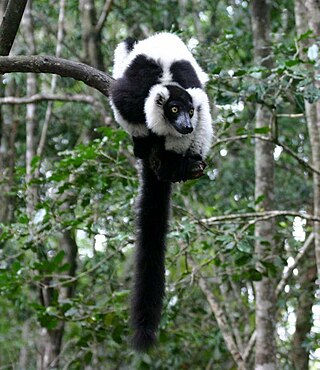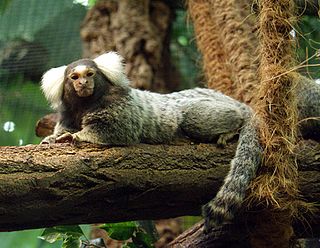
Silence is the absence of ambient audible sound, the emission of sounds of such low intensity that they do not draw attention to themselves, or the state of having ceased to produce sounds; this latter sense can be extended to apply to the cessation or absence of any form of communication, whether through speech or other medium.

Animal communication is the transfer of information from one or a group of animals to one or more other animals that affects the current or future behavior of the receivers. Information may be sent intentionally, as in a courtship display, or unintentionally, as in the transfer of scent from predator to prey with kairomones. Information may be transferred to an "audience" of several receivers. Animal communication is a rapidly growing area of study in disciplines including animal behavior, sociology, neurology and animal cognition. Many aspects of animal behavior, such as symbolic name use, emotional expression, learning and sexual behavior, are being understood in new ways.
A hum is a sound made by producing a wordless tone with the mouth closed, forcing the sound to emerge from the nose. To hum is to produce such a sound, often with a melody. It is also associated with thoughtful absorption, 'hmm'.

In ethology, territory is the sociographical area that an animal consistently defends against conspecific competition using agonistic behaviors or real physical aggression. Animals that actively defend territories in this way are referred to as being territorial or displaying territorialism.

The ring-tailed lemur is a medium- to larger-sized strepsirrhine (wet-nosed) primate, and the most internationally-recognized lemur species, owing to its long, black-and-white, ringed tail. It belongs to Lemuridae, one of five lemur families, and is the only member of the Lemur genus. Like all lemurs, it is endemic to the island of Madagascar, where it is endangered. Known locally in Malagasy as maky or hira, it ranges from gallery forests to spiny scrub in the southern regions of the island. It is omnivorous, as well as the most adapted to living terrestrially of the extant lemurs.

Pygmy marmosets are two species of small New World monkeys in the genus Cebuella. They are native to rainforests of the western Amazon Basin in South America. These primates are notable for being the smallest monkeys in the world, at just over 100 g (3.5 oz). They are generally found in evergreen and river-edge forests and are gum-feeding specialists, or gummivores.

The ruffed lemurs of the genus Varecia are strepsirrhine primates and are the largest extant lemurs within the family Lemuridae. Like all living lemurs, they are found only on the island of Madagascar. Formerly considered to be a monotypic genus, two species are now recognized: the black-and-white ruffed lemur, with its three subspecies, and the red ruffed lemur.

The common marmoset also called white-tufted marmoset or white-tufted-ear marmoset is a New World monkey. It originally lived on the northeastern coast of Brazil, in the states of Piaui, Paraiba, Ceará, Rio Grande do Norte, Pernambuco, Alagoas, and Bahia. Through release of captive individuals, it has expanded its range since the 1920s to Southeast Brazil, where it became an invasive species, raising concerns about genetic pollution of similar species, such as the buffy-tufted marmoset, and predation upon bird nestlings and eggs.

The brown-mantled tamarin, also known as Spix's saddle-back tamarin, is a species of saddle-back tamarin. This New World monkey is found in the Southern American countries of Bolivia, Brazil and Peru. This omnivorous member of the Callitrichidae family is usually found in smaller groups ranging between 4 and 15 individuals. This species communicates vocally and largely rely their olfactory system. The brown-mantled tamarin is considered as a species of Least Concern by the International Union for Conservation of Nature, despite a decreasing population and being threatened by poaching, habitat loss and capture for the illegal pet trade.
Evolutionary musicology is a subfield of biomusicology that grounds the cognitive mechanisms of music appreciation and music creation in evolutionary theory. It covers vocal communication in other animals, theories of the evolution of human music, and holocultural universals in musical ability and processing.

Sofia Zoo in Sofia, the capital of Bulgaria, was founded by royal decree on 1 May 1888, and is the oldest and largest zoological garden in Southeast Europe. It covers 36 hectares and, in March 2006, housed 4,850 animals representing 840 species.

Exmoor Zoo is a conservation centre in Exmoor, North Devon, England. The zoo developed from Exmoor Bird Gardens, opened on the site of a farm in 1982. The current owners took over in 1993, and have enlarged and developed the zoo, now specialising in the conservation of smaller animals. The zoo has been a member of BIAZA, the British and Irish Association of Zoos and Aquariums, since 1995 and recently became a member of EAZA in 2018.

Coquerel's sifaka is a diurnal, medium-sized lemur of the sifaka genus Propithecus. It is native to northwest Madagascar. Coquerel's sifaka was once considered to be a subspecies of Verreaux's sifaka, but was eventually granted full species level, and is listed as Critically Endangered on the IUCN Red List due to habitat loss and hunting. In popular culture, it is known for being the species of the title character in the children's TV show Zoboomafoo. The species was named after French entomologist Charles Coquerel.

Shanghai Zoological Park, or commonly Shanghai Zoo in short, is the main zoological garden in Shanghai. It is located near the township of Hongqiao and is administratively in Changning District. Shanghai Zoo was formerly known as " Xijiao Park", which is still a common name used locally for the zoo.

Newquay Zoo is a zoological garden located within Trenance Leisure Park in Newquay, England. The zoo was opened in Cornwall on Whit Monday, 26 May 1969 by the local council. It was privately owned by Mike Thomas and Roger Martin from 1993 until 2003. In August 2003 Stewart Muir became the new Director and the zoo became part of the Whitley Wildlife Conservation Trust, alongside Paignton Zoo and Living Coasts. The zoo is part of a registered charity, and was awarded various South West and Cornwall 'Visitor Attraction of The Year' and 'Sustainable Tourism' awards for excellence in 2006, 2007 and 2008. Newquay Zoo is now run as part of the Wild Planet Trust, the new name for the Whitley Wildlife Conservation Trust.

Cousins is a nature documentary TV series produced by the BBC Natural History Unit in Bristol, England, first transmitted in the UK on BBC One in August 2000. The series looks at the primates, the closest living relatives to human beings.

The Budapest Zoo & Botanical Garden is the oldest zoo in Hungary and one of the oldest in the world.

World of Birds Wildlife Sanctuary and Monkey Park is an avian, reptilian and wildlife sanctuary in Hout Bay, a suburb of Cape Town in South Africa. As suggested by its name, the focus is primarily on birds and monkeys. It is the largest African bird park and among the bird parks in the world with the higher number of species.

Wildlife HQ Zoo, is located at the Big Pineapple, Woombye, Queensland on the Sunshine Coast, Queensland and opened in November 2013. In March 2014 many animals were relocated from the now closed Alma Park Zoo.

Darling Downs Zoo is a zoo situated in Pilton, Queensland, Australia. The zoo is divided into four separate geographical areas featuring animals mostly from Africa, South America, South-East Asia and Australia.


















